

WALS Online - LINGUIST List 32.1166: FYI: The Proceedings of the 10th Linguistic Meeting of the University of Antarctica. LINGUIST List 32.1166 Thu Apr 01 2021.
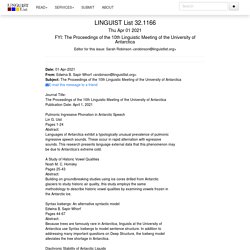
Forthcoming: The languages of Antarctica. This volume is the first to tackle the languages of Antarctica and gives a comprehensive overview of the linguistic research on this contintent.
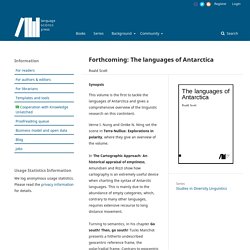
Verne I. Nung and Ontke N. Relationship between different scripts used in languages across the world. Anthropology, linguistics, archaeology, and writing systems. Universal Dependencies. Andrew Perfors. If you think what fictional characters say is unrealistic, try my family's real-world conversations. People really say crazy, implausible, ridiculous things—more often than you might think. Human Systems In Action. ©2004, Gerald M.

Weinberg, www.geraldmweinberg.com Late one summer, I was called in to help an IT client learn to work better with their customers. Untitled. Pictish language. Extinct language spoken by the Picts Pictish is the extinct language spoken by the Picts, the people of eastern and northern Scotland from the late Iron Age to the Early Middle Ages.
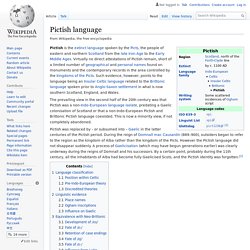
Virtually no direct attestations of Pictish remain, short of a limited number of geographical and personal names found on monuments and the contemporary records in the area controlled by the kingdoms of the Picts. Such evidence, however, points to the language being an Insular Celtic language related to the Brittonic language spoken prior to Anglo-Saxon settlement in what is now southern Scotland, England, and Wales. Joseph Jordania. We ask you, humbly: don't scroll away.

Hi, reader in Canada, it seems you use Wikipedia a lot; that's great! This is the 8th appeal we've shown you. Rebecca Gomez.
ANAGRAMATRON. Recursion. Language Log » Why "deep learning" (sort of) works. « previous post | next post » A recent SMBC implicitly calls Aristotelian taxonomies into question:

Future Language. "Dr.

Buffington says that you have done research involving the deciphering of ancient writings. " He stopped and waited for a reply. Surprised, I answered: "Why yes, I did some digging in a pre-Etruscan site in Italy about fifteen years ago: doctoral research. " I shuddered at the memory of that enforced stay in that ridiculously deep gravity well. On the Existence of Powerful Natural Languages · Gwern.net. Designed formal notations & distinct vocabularies are often employed in STEM fields, and these specialized languages are credited with greatly enhancing research & communication.
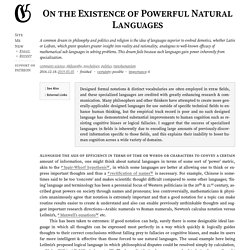
Many philosophers and other thinkers have attempted to create more generally-applicable designed languages for use outside of specific technical fields to enhance human thinking, but the empirical track record is poor and no such designed language has demonstrated substantial improvements to human cognition such as resisting cognitive biases or logical fallacies. I suggest that the success of specialized languages in fields is inherently due to encoding large amounts of previously-discovered information specific to those fields, and this explains their inability to boost human cognition across a wide variety of domains. I would have to say that the answer appears to be no. This is a linguistics controversy. Now there are two of them. There are two ____.
Words. Introduction: You’re listening to Radiolab from WNYC and NPR.

Mema Interretialia. Ricardus - Hyde & Rugg. Untitled. Children Are Using Emoji for Digital-Age Language Learning. Ńdébé : A Modern Ìgbò Script. THE LANGUAGE USED IN TALKING TO DOMESTIC ANIMALS - BOLTON - 1897 - American Anthropologist - Wiley Online Library. Dunn2013. Yanyuwa. Sounds like something out of an English-language textbook.
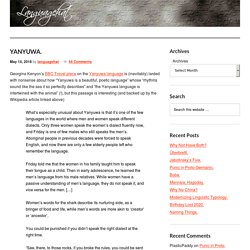
It sounds entirely American to me. The United States is perhaps the lowest-context culture that has ever existed, and I conjecture that such complex rituals are needed to overcome the barriers of misunderstanding and, yes, hostility. Yenish language. Components[edit] The Yenish vocabulary contains many words of Romani and Yiddish (and through this route, Hebrew) origin; it also has many unusual metaphors and metonomies that replace the standard German words. The relationship between Yenish and standard German is comparable to the relationship between Cockney or Polari and standard English. Some original Yeniche words have become parts of standard German.
Animal communication. Semantics. Historical. Syntax. Phonetics. How does language emerge? New study provides insights into the first steps. How did the almost 6000 languages of the world come into being? Researchers from the Leipzig Research Centre for Early Childhood Development at Leipzig University and the Max Planck Institute for Evolutionary Anthropology have tried to simulate the process of developing a new communication system in an experiment -- with surprising results: even preschool children can spontaneously develop communication systems that exhibit core properties of natural language. How the languages of the world emerged is largely a mystery.
Considering that it might have taken millennia, it is intriguing to see how deaf people can create novel sign languages spontaneously. Observations have shown that when deaf strangers are brought together in a community, they come up with their own sign language in a considerably short amount of time. The most famous example of this is Nicaraguan Sign Language, which emerged in the 1980s. Gadsby: Wikip dias Lost Lipogram.